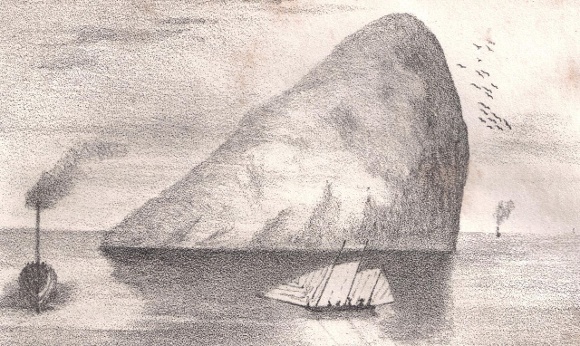John Keats, selected poems Contents
- Social and political context
- Religious and philosophical context
- Literary context
- Bright Star! Would I were steadfast as thou
- The Eve of St Agnes
- ‘Hush, hush! tread softly! hush, hush, my dear!’
- Isabella: or The Pot of Basil
- La Belle Dame Sans Merci
- Lamia
- Lines to Fanny (‘What can I do to drive away’)
- O Solitude, if I must with thee dwell
- Ode on a Grecian Urn
- Ode on Indolence
- Ode to a Nightingale
- Ode to Autumn
- Ode to Melancholy
- Ode to Psyche
- On First Looking Into Chapman’s Homer
- On Seeing the Elgin Marbles
- On the Sea
- Sleep and Poetry
- Time’s sea hath been five years at its slow ebb
- To Ailsa Rock
- To Leigh Hunt
- To Mrs Reynolds’s Cat
- To My Brothers
- To Sleep
- When I have fears that I may cease to be
To Ailsa Rock: Synopsis and Commentary
Synopsis of To Ailsa Rock
This sonnet is addressed to Ailsa Rock, a ‘craggy ocean pyramid’. The first eight lines are an address to the rock, full of questions about its age. The last six lines are the speaker’s own answers to the questions, since the rock cannot answer itself. The lines reflect on the rock’s vast age and its dual existence both below the waves and in the air. The rock is a natural phenomenon that even another natural phenomenon (an earthquake) could not possibly awaken.
 Commentary on To Ailsa Rock
Commentary on To Ailsa Rock
The sonnet was written during the walking tour of Scotland that Keats made with his friend Charles Brown in the summer of 1818. They walked twenty-seven miles from Portpatrick to Ballantrae via Stranraer. Passing through landscape of great beauty, they caught sight of Ailsa Rock which Keats described in a letter to his brother Tom as ‘seventeen miles distant, rising perpendicularly from the sea nine hundred and forty feet’.
That night there was a storm which deprived them of sleep whilst staying in an inn at Ballantrae. The following day they walked though rain with the great rock still lowering in the distance and seeming to follow them like some primeval companion. The spectacle began to disturb Keats, especially since, by an optical illusion, the rock seemed to float in the misty rain, giving him ‘a complete Idea of a deluge’.
He told Tom that he was ‘a little alarmed’ so, to exorcise ‘the rock’s haunting spirit’, Keats wrote this sonnet to express something of the horror he felt in the deeply mysterious presence of a giant object which is undoubtedly ‘dead’ but which seems in some ways alive and open to question.
Glossary
pyramid: a monumental structure with a square or triangular base and sloping sides that meet in a point at the top, especially one built of stone as a royal tomb in ancient Egypt
mantled: covered in a cloak
the mighty power: The conventional belief of Keats’ day was that God created and shaped the world.
coverlid: A ‘coverlet’ was the term used in Keats’ day to refer to a bed covering (such as a bedspread or eiderdown), which Keats here adapts to include the idea of a lid keeping contents within.
fathom: a unit of length equal to 1.8 metres, used to measure the depth of water.
Investigating commentary on To Ailsa Rock...
- In what ways is it particularly helpful to know the biographical context surrounding this poem?
- Keats said that he wrote this sonnet to exorcise ‘the rock’s haunting spirit’. What was it about the rock that had disturbed him so intensely?
Recently Viewed
Related material
Scan and go
Scan on your mobile for direct link.